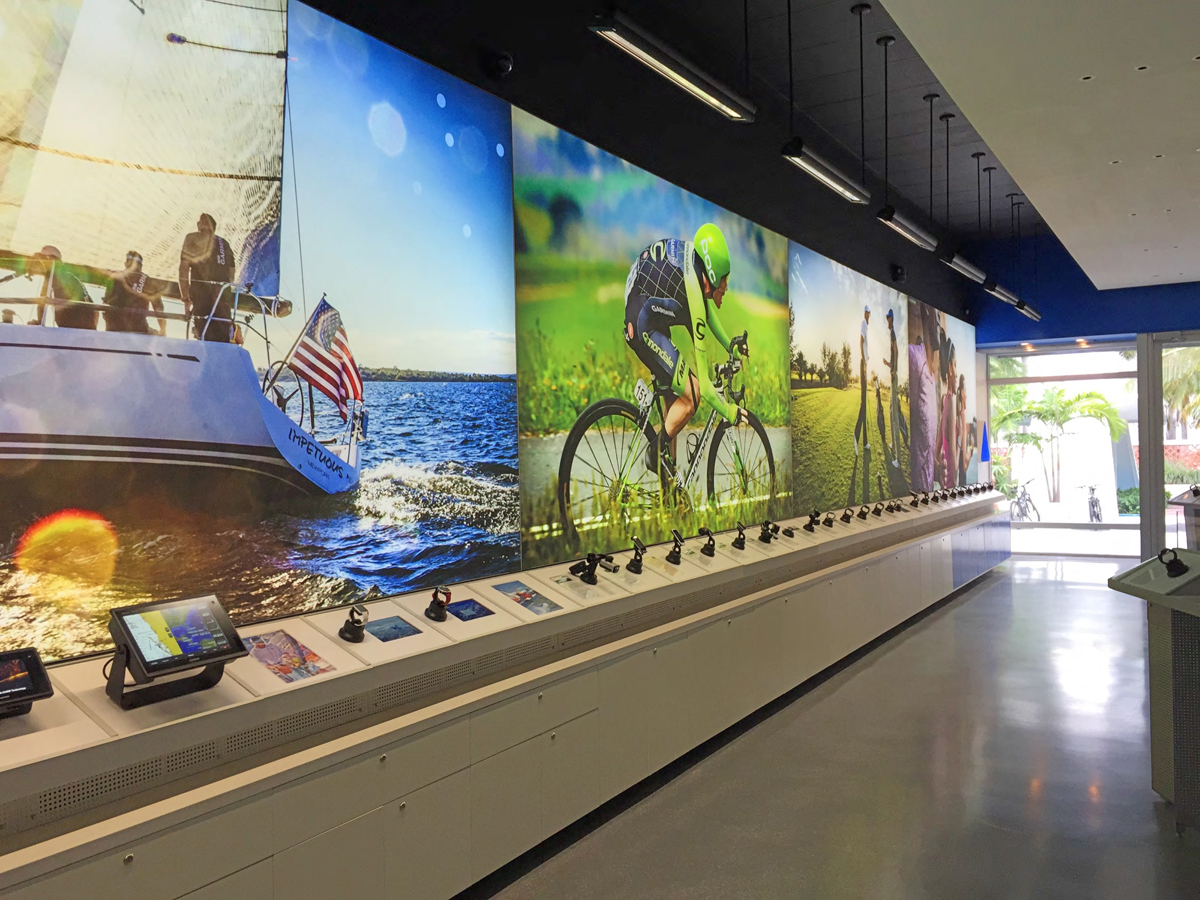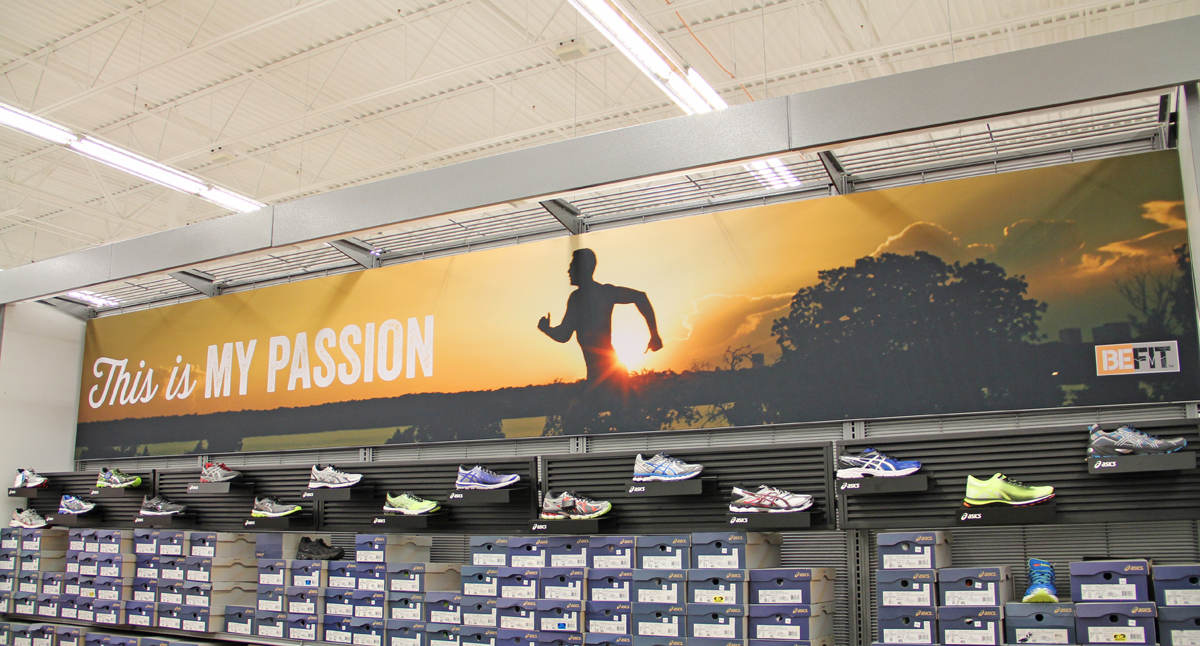Banners + Awnings
The Ultimate Soft Sell
How the rise of fabric is spurring growth in the soft-signage market.
Published
6 years agoon

It’s a chilly January evening in Las Vegas, 8 p.m. You’re a thousand miles from home, setting up your tradeshow booth on the floor of a convention center. Your flight got in later than expected, but with the exhibition floor opening at 10 a.m. tomorrow morning, you’ve got all the time in the world to set up. You carefully reach into the heavy crate the event staff brought up earlier today and lift out one of your rigid substrates, only to realize the unthinkable has happened – all four corners of the 1/4-in. PVC board are broken, and there’s no way you can get a replacement here in time.
Disheartened, you glance across the aisle to see one of your fellow plane passengers inserting a final Silicone Edge Graphic, or SEG, into their own booth’s backdrop. The thin silicone strip on the back of the dye-sublimated fabric slips smoothly and easily into the recessed groove of the metal frame, pulling the material taut and displaying their company’s branding with an impressive vibrancy and brilliance.
In that moment you realize two things: One, if you ever bring rigid materials to another tradeshow, you’ll double – no, triple-check – that they’re packed safely; and two, you’ll never bring rigid materials to another tradeshow.
In 2015, an SGIA Journal author estimated 1 billion square meters of textiles would be printed that year, with a 30% annual growth forecast through 2019 (see “The Evolving Soft Signage Market: Part 1,” November/December). From retailers to event organizers, corporate rebrands to pop-up shops, it’s clear that as consumer demand rises and the cost of dye-sublimation printers, inks and materials continues to drop, soft signage is making a big dent in the industry.
A SOFT SPOT FOR ANY INDUSTRY
With production facilities in Minnesota and North Carolina, Imagine! Print Solutions is a 30-year-old graphic communications company with more than 1,600 employees. It’s also the parent company of Imagine! Express, a Minneapolis-based print shop with an 80,000-sq.-ft. facility specializing in commercial printing, direct mail and high quality fabric prints.
“Soft signage isn’t the largest portion of our product mix,” said Keri Sanders, director of customer experience, “but it’s definitely our fasting growing segment.” The shop’s EFI VUTEk FabriVU 340 and EFI Reggiani PRO 340 produce a wide mix of content for tradeshow graphics, corporate décor, museums and the hot trend taking over the retail world: 24- to 48-hour pop-up shops, restaurants and event spaces.
AdvertisementGone are the days of a single rigid backdrop for exhibitions and tradeshows, Sanders said. “We’re seeing more and more requests for creative booth builds, featuring one-of-a-kind structures.” With the popularity of silicone-edge graphics frames and other tension systems, clients are looking for new and interesting ways to set themselves apart on crowded show floors, an area where fabric – with its ability to create easy-to-install, eye-catching spaces – is a perfect fit. “We once used fabric to build an indoor barn for an equine nutrition-related client,” Sanders said. “No one had seen that before.”

Corporations and museums are also putting fabrics to use, whether to delineate space from one department to the next or to rebrand and refocus their mission and culture. With textiles, Imagine! can incorporate blockout backing to divide a room, or leave the natural fabric back as-is to allow for a more translucent effect, giving clients flexibility in the look and feel of their office space. In the tech space, Sanders said, Imagine! sees institutional companies competing with Silicon Valley tech giants, updating their offices or dressing up campuses to better recruit millennials.
The most interesting growth industry, Sanders noted, surrounds pop-up shops for retail and events. This type of “here today, gone tomorrow” setup, often featuring a variety of lifestyle graphics and product mixes, can take place in any space, from an existing store that gets rebranded to an unused warehouse that’s transformed overnight into a pop-up shop. “With fabric,” Sanders said, “everything goes up and comes down quickly. It’s almost like you were never there” – except for the lasting impressions left on those who were lucky enough to be present.
THINKING SMALLER, SOFTER
After nearly 60 years in business, BPGraphics’ team in Phoenix is well-known for their craftsmanship, expertise and exceptional work in large-, wide- and grand-format printing. Operating from its 66,000-sq.-ft.-plus production facility, the company offers a complete line of screen and digital printing and finishing in-house, according to Nicholas Spade, director of marketing.
“Much of our work is still in OOH [out-of-home], such as building wraps, train wraps, billboards,” said Spade. “But smaller scale, soft-signage sales like fabrics, hanging banners, step-and-repeats and store windows continue to grow from one year to the next.”
AdvertisementMany airports, Spade continued, are replacing backlits with fabrics because they’re easier to change out and have sound-dampening properties in high-trafficked areas. Companies exhibiting at conferences and tradeshows, he added, are looking for more cost-effective, travel-friendly solutions, and seem to be moving from full booths to expandable three-wall setups that can fit in a travel bag.
One of the biggest advantages in the “shift to soft?” Shipping. “As transportation prices increase and it becomes more expensive to send giant crates with rigid signs across the country,” Spade said, “the allure of folding up an 8 x 12-ft. piece of fabric, throwing it in a small box and shipping it overnight for a fraction of the cost not only saves money, but makes rushes easier, too.”
And rush they can. On the shop’s PrinterEvolution Evo33 DS, a water-based dye-sublimation press, BPGraphics can produce up to 1,300 sq. ft. of graphics at 126-in.-wide per hour. The prints are then transferred onto a wide variety of fabrics using 400° of heat and extreme pressure from their Monti Antonio 901 Heat Calender.
The specialized equipment that creates fabric’s beautiful, bold textures and colors is more challenging to run than a traditional “ink on substrate” press. “Dye-sublimation requires an entire second step – sublimating the inks (dyes) into the fabric through a heat calender,” said Spade. During this process, you have to consider that each fabric type responds differently to the required heat and pressure, and different-size graphics require different settings. A skilled operator is as much craftsman as technician.
Other issues crop up with fabrics that don’t typically occur with rigid substrates, as BPGraphics learned when they had to create 800 Super Mario-themed bollard covers for the release of Mario Kart 8 Deluxe for Target. For instance, how do you keep a material that’s designed to stretch from doing exactly that on a Zund or other digital flatbed cutter? “When exact cuts are required, then precise sewing, it takes time and patience from all parties involved,” Spade said. The result of that trial and error? A successful and popular campaign that garnered national attention.
A SOFT TOUCH AND A KEEN EYE
“There’s just something about fabric,” said Bill Stender, owner of SF Landmark in San Francisco. “Color has been my thing for 30 years, and dye-sublimation offers the most compelling color I’ve ever seen.” Serving Hollywood film studios and Bay-area businesses since 1982, SF Landmark offers everything from large-format digital printing and grand-format dye-sublimated fabric, to dimensional signage and major motion picture props.
With its close proximity to the Moscone Center, the largest convention and exhibition complex in San Francisco, SF Landmark sees no shortage of tradeshow business. “There are shows going on every week or weekend, all year long,” said Stender. And while rigid UV, roll-to-roll printing and dimensional signs have been lucrative in the past, fabrics and textiles have been steadily picking up steam over the last decade or so. Stender thinks he knows why: “Fabric has a particular sheen that can’t be achieved with other substrates. It’s softer, elegant, inviting. Clients love that you can get up close to it, touch it.”
On the shop’s EFI VUTEk FabriVU 340, 15-ft.-wide Klieverik heat press calendar and Matic sewing system, Stender and his team recently produced a series of near-seamless, 20-ft.-wide by 12-ft.-high backdrops for a local photographer, who Stender believes is among his most demanding clientele, as photographers “have an eye for color – it absolutely has to be right.” The result? A glowing endorsement: “The client said all he had to do was shine a light on the fabric and shoot. There weren’t any lighting issues like there usually are with rigid, digitally printed backgrounds.”
Still, if you’re thinking about getting your shop into fabric, Stender cautioned that it’s not for the faint of heart. “There’s a steep learning curve involved. It’s a whole different animal than we’re used to with digital.” The different fabric materials, he noted, all appear relatively the same in their respective ordering books; however, they all possess varying thicknesses (which affects the transfer process), white points, stretch factors, weaves and more. “These are things you don’t really have to worry about with digital printing on rigid substrates.”
In the end though, Stender insisted, “There’s nothing in digital printing that compares to the stunning color and rich quality you can achieve with fabrics.”

SPONSORED VIDEO
Introducing the Sign Industry Podcast
The Sign Industry Podcast is a platform for every sign person out there — from the old-timers who bent neon and hand-lettered boats to those venturing into new technologies — we want to get their stories out for everyone to hear. Come join us and listen to stories, learn tricks or techniques, and get insights of what’s to come. We are the world’s second oldest profession. The folks who started the world’s oldest profession needed a sign.
You may like
Advertisement
Subscribe

Magazine
Get the most important news
and business ideas from Signsofthetimes Magazine.
Advertisement
Most Popular
-

 Tip Sheet1 week ago
Tip Sheet1 week agoAlways Brand Yourself and Wear Fewer Hats — Two of April’s Sign Tips
-

 Photo Gallery1 day ago
Photo Gallery1 day ago30 Snapshots of the 2024 ISA Sign Expo
-

 Ask Signs of the Times3 days ago
Ask Signs of the Times3 days agoWhy Are Signs from Canva so Overloaded and Similar?
-

 Real Deal1 week ago
Real Deal1 week agoA Woman Sign Company Owner Confronts a Sexist Wholesaler
-

 Benchmarks6 days ago
Benchmarks6 days ago6 Sports Venue Signs Deserving a Standing Ovation
-

 Editor's Note2 weeks ago
Editor's Note2 weeks agoWhy We Still Need the Women in Signs Award
-

 Women in Signs1 week ago
Women in Signs1 week ago2024 Women in Signs: Megan Bradley
-

 Photo Gallery1 week ago
Photo Gallery1 week ago21 Larry Albright Plasma Globes, Crackle Tubes and More









